Astronomy Test 3
4.5(2)
Card Sorting
1/191
There's no tags or description
Looks like no tags are added yet.
Study Analytics
Name | Mastery | Learn | Test | Matching | Spaced |
|---|
No study sessions yet.
192 Terms
1
New cards
What is hydrostatic equilibrium
a balance of gravity pulling in and pressure from heat pushing out
2
New cards
Luminosity
total energy radiated by a star (total brightness)
* total brightness
* total brightness
3
New cards
What is nuclear fusion
joining of 2 nuclei together to form different one
* requires high temp, and density to overcome electrical repulsion
* requires high temp, and density to overcome electrical repulsion
4
New cards
A star becomes stable when what?
When the outward forces of expansion from the energy released in nuclear fusion reactions balance the inward forces of gravity
5
New cards
Very massive stars
are rare
6
New cards
Low-mass stars
are common
7
New cards
We are “star stuff” because
The elements necessary for life we made in stars
8
New cards
The sun sits about where?
About 2/3 of the way from the center to the edge of the disk
9
New cards
The sun revolves around the center of the galaxy about once every
250 million years
10
New cards
Origin of stars
Stars are born in Nebulas which are swirling clouds of hydrogen gas
11
New cards
The matter between the stars are collectively termed as interstellar medium. It’s made out of 2 components
Gas (75% Hydrogen, 25% helium) a little of other gases and dust
12
New cards
Any interstellar cloud of gas and dust is called a
Nebula (plural Nebulae)
13
New cards
Evidence of Nebulae
* spectral lines
* reddening of stars
* reddening of stars
14
New cards
Stars form in where?
Dark cloudy dusty gas in interstellar space
15
New cards
Interstellar medium
The gas between the stars
16
New cards
Emission Nebula
A nebula with the characteristic emission line spectrum of a hot, thin gas
17
New cards
The vast amounts of UV radiation emitted by the close by Hot, type O or type B stars are absorbed by
The hydrogen atoms in Nebulae
18
New cards
Emission nebular are referred to as
H II regions
19
New cards
Dark nebula
A nebula so opaque that it blocks visible light that are emitted from stars behind the nebula
20
New cards
Reflection nebula
Doesn’t produce its own light like emission nebulae, but scatters star light
* scattering is due to the dust grains
* lower concentration of dust grains than dark nebulae
* scattering gives rise to blue color
* scattering is due to the dust grains
* lower concentration of dust grains than dark nebulae
* scattering gives rise to blue color
21
New cards
Interstellar extinction
The intensity of star light is reduced as light passes through the interstellar medium
22
New cards
Interstellar reddening
When a light from a star pass through interstellar medium, dust particles absorb or scatter blue light allowing red light to pass through (like a sunset on earth)
23
New cards
Long-wavelength infrared light passes through a cloud more easily than
Visible light
24
New cards
Observations of infrared light reveal stars
On the other side of the cloud
25
New cards
Giant molecular clouds
In certain cold regions of interstellar space, atoms combine to form molecules
26
New cards
Stars are born in
Molecular clouds consisting mostly of hydrogen molecules
27
New cards
Stars from in places where gravity can
Overcome thermal pressure in a cloud
28
New cards
Star-forming clouds emit infrared light because
The heat generated as stars form
29
New cards
Infrared observations can directly detect
Dust in the interstellar medium
30
New cards
Some molecules in the cold gas emit in the
Infrared- infrared observations can detect very cold clouds of gas
31
New cards
The birth and life of any star can be described as a battle between two forces
Gravity vs. internal pressure
32
New cards
Gravity always wants to what
collapse a star
33
New cards
internal pressure wants to what?
hold up a star
34
New cards
Newton’s law of gravity
* the amount of gravitational force depends on the mass
* gravitational potential energy is turned into heat as a star collapses
* gravitational potential energy is turned into heat as a star collapses
35
New cards
In the densest clouds, hydrogen can exist as what?
As molecules (H2) rather than atoms
* These clouds are called **Molecular clouds**
* These clouds are called **Molecular clouds**
36
New cards
Formation of stars form the interstellar medium- **An interstellar molecular cloud**
* star formation begins when part of the interstellar molecular cloud contracts under its own gravitational attraction- denser regions in the clouds are favorable for star formation
* the gravitational collapse overwhelms the presssure-colder regions are more favorable since they aren’t low-pressure regions
* these cold dense regions of clouds collapse under its own weight to form clumps, future stars
* the gravitational collapse overwhelms the presssure-colder regions are more favorable since they aren’t low-pressure regions
* these cold dense regions of clouds collapse under its own weight to form clumps, future stars
37
New cards
Formation of stars from the interstellar medium- **Contracting Cloud**
Star formation is triggered when a sufficiently massive pocket of gas is squeezed by some external event
* material flowing out of protostars cause shock waves that trigger regions nearby to collapse
* a supernova explosion of a dying star can compress the surrounding gas triggering a collapse
* material flowing out of protostars cause shock waves that trigger regions nearby to collapse
* a supernova explosion of a dying star can compress the surrounding gas triggering a collapse
38
New cards
A star-forming cloud colliding with a shock wave can
be compressed and break into fragments
* some of these fragments can become dense enough to collapse under gravity and form stars
* some of these fragments can become dense enough to collapse under gravity and form stars
39
New cards
Fragmentation of a cloud- gravity within a contracting gas cloud becomes stronger as
the gas becomes denser
40
New cards
fragmentation of a cloud- gravity can therefore overcome pressure in smaller pieces of cloud, causing it to break apart into
multiple fragments, each of which may go on to form a star
41
New cards
Each lump of the cloud in which gravity can overcome pressure can
go on to become a star
42
New cards
A large cloud can make
a whole cluster of stars
43
New cards
The dense opaque region at the center is called a
protostar- an embryonic object at the dawn of star birth
44
New cards
observing the infrared light from a star cloud can reveal
the newborn star embedded inside it
45
New cards
Solar-system formation is a good example of
star birth
46
New cards
the rotation speed of the cloud from which a star forms increases as
the cloud contracts
47
New cards
rotation of a contracting cloud speeds up for the same reason
a skater speeds up as she pulls in her arms
48
New cards
what is flattening
collisions between particles in the cloud cause it to flatten into a disk
49
New cards
formation of jets
jets are observed coming from the centers of disks around protostars
50
New cards
from protostar to main sequence- protostars looks starlike after the surrounding gas is blown away, but its thermal energy comes from
gravitational contraction, not fusion
51
New cards
from protostar to main sequence- contraction must continue until the core
becomes hot enough for nuclear fusion (10,000,000 K)
52
New cards
from protostar to main sequence- contraction stops when the energy released by core fusion balances energy radiated from the surface- the star is now
a main-sequence star
53
New cards
when thermonuclear reactions start at the center of a protostar
we say a new star is born
54
New cards
summary of star birth
1. gravitational causes gas clouds to shrink and fragment
2. core of shrinking cloud heats up
3. when ore gets hot enough, fusion begins and stops the shrinking
4. new star achieves long-lasting state of balance
55
New cards
stages of star formation on the H-R diagram- life track illustrates star’s surface temperature and
luminosity at different moments in time
56
New cards
evidence of star formation
* bipolar flow from young stars
* star forming regions
* young star clusters
* star forming regions
* young star clusters
57
New cards
Summary: How do stars form?
* stars are born in cold, relatively dense molecular clouds
* as a cloud fragment collapses under gravity, it becomes a protostar surrounded by a spinning disk of gas
* the protostar may also fire jets of matter outward along its poles
* protostars rotate rapidly, and some may spin so fast that they split to form close binary systems
* as a cloud fragment collapses under gravity, it becomes a protostar surrounded by a spinning disk of gas
* the protostar may also fire jets of matter outward along its poles
* protostars rotate rapidly, and some may spin so fast that they split to form close binary systems
58
New cards
Which range of the electromagnetic spectrum is best for observing newly formed stars or inside of the clouds where stars are born?
Infrared
59
New cards
The birth of a star is designated with what?
with the start of hydrogen to helium, fusion in all stars
60
New cards
Star starts dying when
hydrogen to helium fusion stops
61
New cards
When is a star born?
Hydrogen fusion proton-proton chain starts at the center of a protostar, we say a new star is born
62
New cards
Cluster formation
1. molecular cloud
2. hot gas
3. young cluster
1. old cluster
63
New cards
There are 2 kinds of clusters
Open and globular
64
New cards
Open clusters
* young clusters of a few 1000 stars
* blue main-sequence and few giants
* blue main-sequence and few giants
65
New cards
Testing stellar evolution- the problem
* stellar evolution happens on billion-year time scales
* astronomers only live for a few 10s of years
* astronomers only live for a few 10s of years
66
New cards
Testing stellar evolution- the solution
Make H-R diagrams of star clusters with a wide range of ages
67
New cards
What are star clusters
group of 100s to 1000s of stars
* are at the same distance so it’s easy to measure
* have the same age
* have the same chemical composition
* have a wide range of stellar masses
* are at the same distance so it’s easy to measure
* have the same age
* have the same chemical composition
* have a wide range of stellar masses
68
New cards
Each cluster provides a snapshot of
what stars of different masses look like at the sane age and composition
69
New cards
Each star cluster freeze-frames and makes what
a visible moment in stellar evolution
* the differences you see among stars in one cluster must arise from differences in their masses
* the differences you see among stars in one cluster must arise from differences in their masses
70
New cards
The main sequence on the H-R diagram is what?
A mass sequence
* massive stars are ^^HOTTER^^ and BRIGHTER
* low-mass stars are ==COOLER== and FAINTER
* massive stars are ^^HOTTER^^ and BRIGHTER
* low-mass stars are ==COOLER== and FAINTER
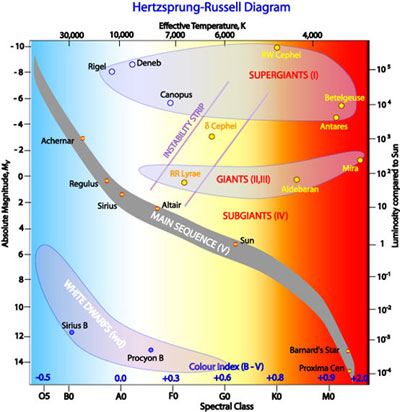
71
New cards
Main sequence lifetime depends on
Mass
* massive stars have SHORT main sequence lifetimes
* low-mass stars have LONG main sequence lifetimes
* massive stars have SHORT main sequence lifetimes
* low-mass stars have LONG main sequence lifetimes
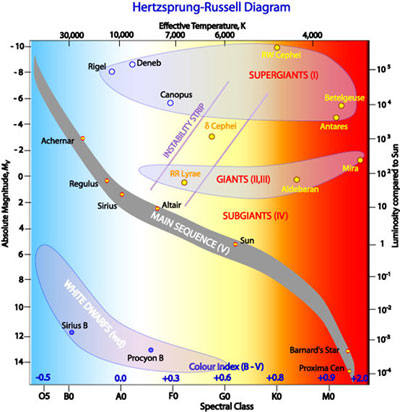
72
New cards
Low-mass stars take longer to do what?
to form
73
New cards
Clusters in the H-R diagram indicate what?
Age
* all stars arrive on the main sequence are about the same age
* the cluster is as old as the most luminous (massive) star left on the main sequence
* all stars arrive on the main sequence are about the same age
* the cluster is as old as the most luminous (massive) star left on the main sequence
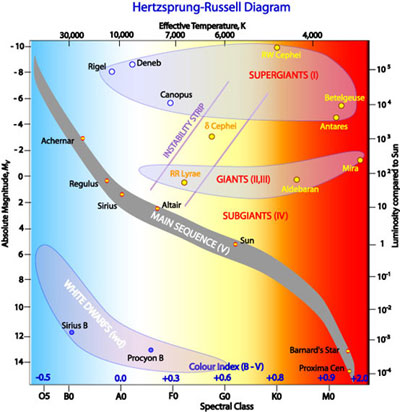
74
New cards
All main sequence stars to the left have already used up their what?
Their H fuel and are gone
75
New cards
The position of the hottest brightest star on a cluster’s main sequence is called the
Main sequence turnoff point
* main sequence turnoff point of a cluster tells us its age
* main sequence turnoff point of a cluster tells us its age
76
New cards
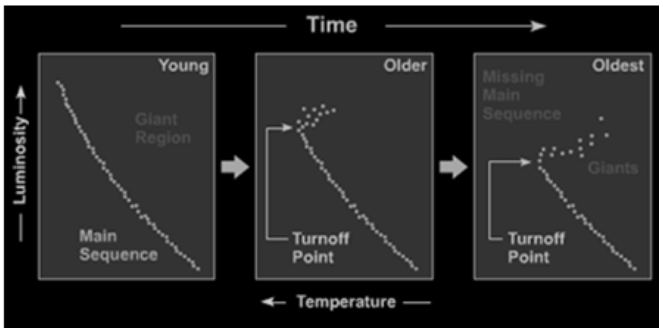
As clusters age they start with high-mass stars on the main sequence and
low mass stars still approaching
77
New cards
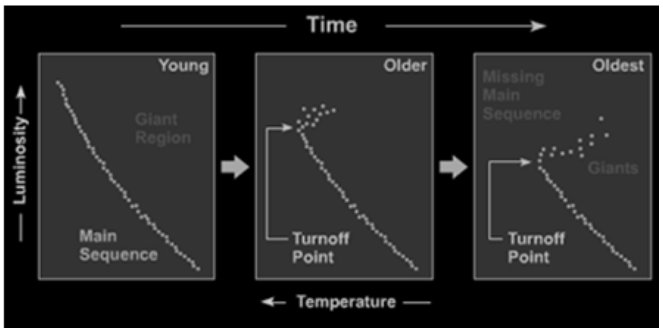
as a cluster ages, high mass run out of
hydrogen in their cores first, evolving off into supergiants
78
New cards
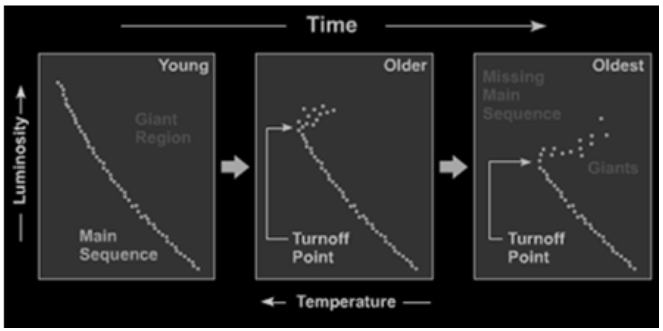
as a cluster ages, lower mass stars run out of
hydrogen in their cores, they too evolve off
79
New cards
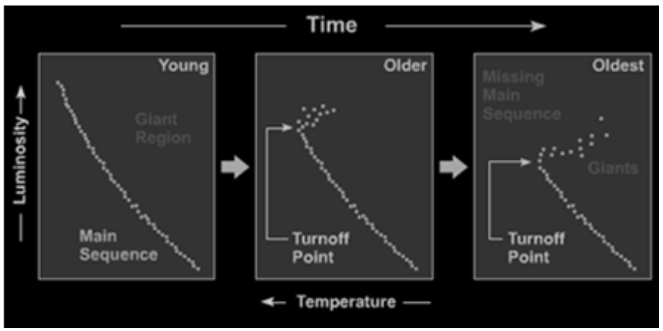
as a cluster ages, stars peel off the main sequence
from the top (high mass end) down as the cluster ages
80
New cards
by comparing clusters of different ages, you can
visualize how stars evolve- almost as if you were watching a film of a star cluster evolving over billions of years
81
New cards
Main sequence turn off
point where the main sequence “turns off” towards giant stars
* as cluster ages, the stars at the turn off are lower mass
* low mass stars have ==redder== colors
* as cluster ages, the stars at the turn off are lower mass
* low mass stars have ==redder== colors
82
New cards
Color of the turn off is an indicator of what?
of the cluster age
* older clusters have ==redder== turn off points
* older clusters have ==redder== turn off points
83
New cards
A star remains on the main sequence as long as it
can fuse hydrogen into helium into its core
84
New cards
The mass of a main sequence star determines its
core pressure and temperature
85
New cards
stars of a higher mass have higher
core temperature and more rapid fusion, making those stars both more luminous and shorter-lived
86
New cards
Stars of lower mass have cooler cores and slower fusion rates, giving them
smaller luminosities and longer lifetimes
87
New cards
The differences in whether a star become a red giant or white dwarf is determined by
the mass of the star
88
New cards
The structure of an average mature star- what reactions occur in the core releasing gamma and X ray radiation?
hydrogen fusion
89
New cards
What radiation moves through the radiation zone from particle to particle eventually heating gases at the bottom of the convection zone?
Gamma and X-ray
90
New cards
What carries energy to the surface where it’s emitted to space as visible light, ultraviolet radiation, and infrared radiation?
Convection cells
91
New cards
What happens when a star can no longer fuse hydrogen to helium in its core?
Core shrinks and heats up
92
New cards
what happens to a star’s inert helium core starts to shrink?
hydrogen fuses in shell around core
93
New cards
as the star contracts, H beings fusing very rapidly to
He in a shell around the core
* luminosity increases because the fusion rate is higher
* size increases: red giant phase
* luminosity increases because the fusion rate is higher
* size increases: red giant phase
94
New cards
Life history of a sunlike star- Helium fusion requires
higher temperature than hydrogen fusion
95
New cards
Life history of a sunlike star- Helium fusion combines
3 He nuclei to make a carbon
96
New cards
Core shrinkage as a star ages- as fuel is exhausted, outward pressure in core drops and gravity
compresses it
97
New cards
The expansion of a star to giant or supergiant size cools the star’s
outer layers (the star moves towards the upper right in the H-R diagram
98
New cards
on the H-R diagram the top left area represents
hot, bright stars
99
New cards
on the H-R diagram the top right represents
cool, bright stars
100
New cards
on the H-R diagram the bottom left represents
hot, dim stars